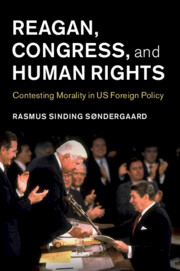Book contents
- Reagan, Congress, and Human Rights
- Human Rights in History
- Reagan, Congress, and Human Rights
- Copyright page
- Contents
- Figures
- Acknowledgments
- Abbreviations
- Introduction
- 1 After the Breakthrough
- 2 The Reagan Turnaround on Human Rights
- 3 The Congressional Human Rights Caucus and the Limits of Bipartisanship
- 4 The Right to Leave
- 5 “A Universal Human Rights Issue”
- 6 Two Tales of Human Rights
- Conclusion
- Bibliography
- Index
4 - The Right to Leave
Soviet Jewish Emigration
Published online by Cambridge University Press: 27 March 2020
- Reagan, Congress, and Human Rights
- Human Rights in History
- Reagan, Congress, and Human Rights
- Copyright page
- Contents
- Figures
- Acknowledgments
- Abbreviations
- Introduction
- 1 After the Breakthrough
- 2 The Reagan Turnaround on Human Rights
- 3 The Congressional Human Rights Caucus and the Limits of Bipartisanship
- 4 The Right to Leave
- 5 “A Universal Human Rights Issue”
- 6 Two Tales of Human Rights
- Conclusion
- Bibliography
- Index
Summary
From the mid-1970s onward, the Soviet Union’s refusal to allow Jews to emigrate became a key human rights issues in East-West diplomacy. Chapter 4 investigates efforts by the Reagan administration, members of Congress, and NGOs to support Soviet Jewish emigration as a fundamental human right during the 1980s. The chapter traces the role of human rights and Jewish emigration in the administration’s foreign policy before summarizing the extensive actions both liberal and conservative members of Congress undertook in support of Soviet Jews. The chapter demonstrates how the administration and a large bipartisan coalition in Congress formed a generally cooperative relationship despite some strategic disagreements. Certain members of Congress urged stronger public criticism of the Soviet Union and a linkage between progress on Jewish emigration and economic and security issues. The chapter argues that members of Congress contributed to keeping Jewish emigration on the political agenda and increased the political costs for Reagan should he fail to deliver on the issue. It also demonstrates that Reagan used congressional concern for Jewish emigration as leverage in negotiations with the Soviets. The chapter concludes that the issue of Jewish emigration facilitated a continued institutionalization of human rights concerns in US foreign policy.
- Type
- Chapter
- Information
- Reagan, Congress, and Human RightsContesting Morality in US Foreign Policy, pp. 118 - 163Publisher: Cambridge University PressPrint publication year: 2020

